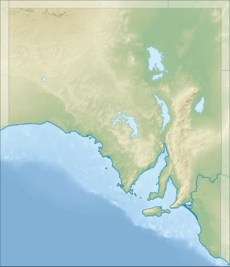Desert Camp Conservation Reserve facts for kids
Quick facts for kids Desert Camp Conservation ReserveMarcollat, South Australia |
|
|---|---|
|
IUCN Category VI (Managed Resource Protected Area)
|
|
| Nearest town or city | Keith. |
| Established | 11 November 1993 |
| Area | 8.82 km2 (3.4 sq mi) |
| Visitation | ‘rarely used’ (in 1997) |
| Managing authorities | Department of Environment, Water and Natural Resources |
| Footnotes | Coordinates Nearest town Managing authority |
| See also | Protected areas of South Australia |
Desert Camp Conservation Reserve is a special protected area in South Australia. It is located in a region called the Limestone Coast. You can find it near a place called Marcollat. It's about 44 kilometers (27 miles) south of the town of Keith.
This reserve is a "Category VI protected area." This means it's a place where people try to protect nature. They also allow some careful use of natural resources. The reserve sits on government-owned land. It is next to the Riddoch Highway. This highway connects Keith in the north to Naracoorte in the south.
Why Desert Camp Reserve is Important
The Desert Camp Conservation Reserve was officially created on November 11, 1993. It was set up to protect the natural environment. The name "Desert Camp" comes from the nearby Desert Camp Conservation Park. This park is located just to the west of the reserve.
In 1997, experts said this area was very important. It was the largest natural bushland left in its local area. More than half of all the remaining native plants in the region were found here.
Amazing Plants and Trees
Scientists have found eight different types of plant groups in the reserve. There are at least 248 kinds of native plants here! Some of these plants are very rare. Seventeen species are rare or threatened in the Limestone Coast area. Ten are rare or threatened in all of South Australia.
One very special plant is the Metallic sun-orchid (Thelymitra epipactoides). This orchid is considered endangered across Australia.
Here are some of the main plant groups you can find:
- Brown stringybark (Eucalyptus baxteri) Low Woodland.
- Pink gum (Eucalyptus fasciculosa) Woodland with a Mixed Heath.
- Pink gum (Eucalyptus fasciculosa) Low Woodland with Desert banksia (Banksia ornata). Also, Heath yacca (Xanthorrhoea caespitose) and Heath tea-tree (Leptospermum myrsinoides) Open Heath.
- South Australian blue gum (Eucalyptus leucoxylon) Woodland.
- Dwarf hakea (Hakea rugosa) and Dwarf sheok (Allocasuarina pusilla). Also, Honey myrtle (Melaleuca brevifolia) Heath.
- Coastal white mallee (Eucalyptus diversifolia) Open Scrub.
- Broombush (Melaleuca uncinata) and Silver broombush (Baeckea behrii) Open Heath.
- Mixed Herbland.
Wonderful Wildlife
The reserve is also home to many animals, especially birds. In 1997, sixteen bird species that need special protection were seen here. This includes the black-chinned honeyeater, which is rare.
Two other bird species are considered vulnerable in South Australia. These are the eastern yellow robin and the malleefowl.
The Desert Camp Conservation Reserve is not a busy place for visitors. Most people who come here are nature lovers and bird watchers. They come to enjoy the quiet and observe the amazing plants and animals.


